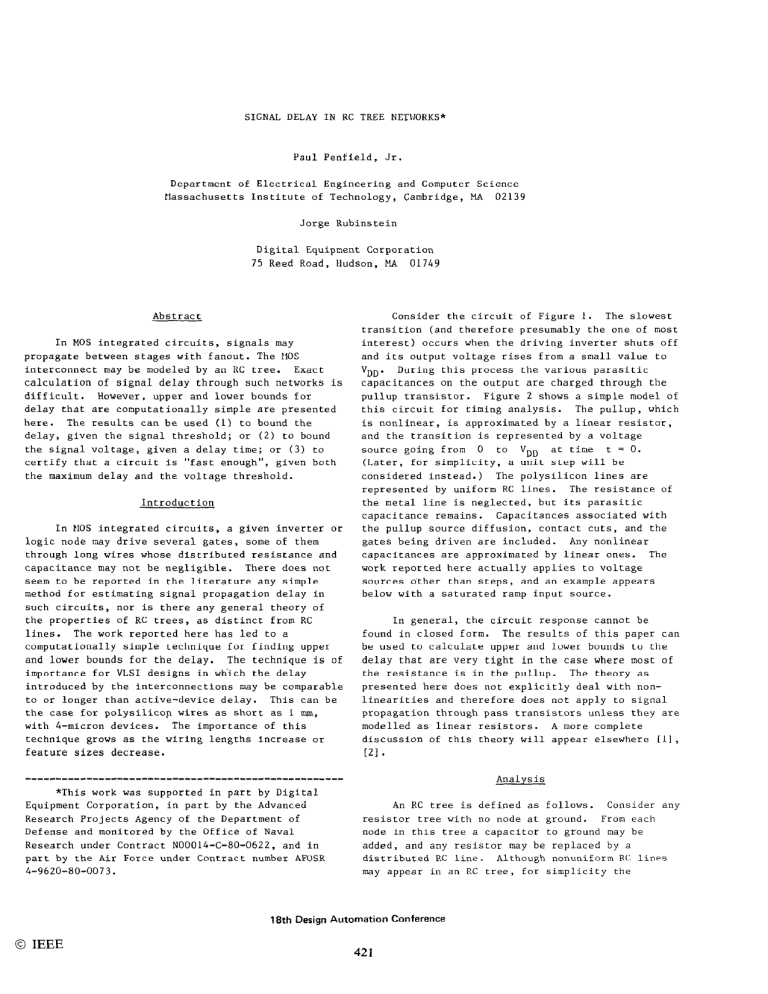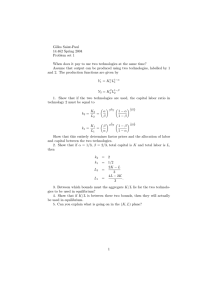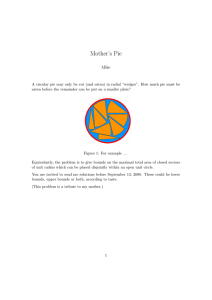
SIGNAL DELAY IN RC TREE NETWORKS* Paul Department Massachusetts of Electrical Institute Digital 75 Reed Penfield, Jr. of Engineering Technology, Jorge Rubinstein and Computer Cambridge, Equipment Gorporation Road, Hudson, HA 01749 Abstract In MOS integrated circuits, signals may propagate between stages with fanout. The HIOS interconnect may be modeled by an RC tree. Exact calculation of signal delay through such networks is difficult. However, upper and lower bounds for delay that are computationally simple are presented here. The results can be used (1) to bound the delay, given the signal threshold; or (2) to bound the signal voltage, given a delay time; or (3) to certify that a circuit is "fast enough", given both the maximum delay and the voltage threshold. Introduction In HOS integrated circuits, a given inverter or logic node may drive several gates, some of them through long wires whose distributed resistance and capacitance may not be negligible. There does not seem to be reported in the literature any simple method for estimating signal propagation delay in such circuits, nor is there any general theory of the properties of RC trees, as distinct from RC The work reported here has led to a lines. computationally simple technique for finding upper and lower bounds for the delay. The technique is of importance for VLSI designs in which the delay introduced by the interconnections may be comparable to or longer than active-device delay. This can be the case for polysilicop wires as short as 1 mm, with 4-micron devices. The importance of this technique grows as the wiring lengths increase or feature sizes decrease. The slowest Consider the circuit of Figure 1. transition (and therefore presumably the one of most interest) occurs when the driving inverter shuts off and its output voltage rises from a small value to During this process the various parasitic "DD. capacitances on the output are charged through the Figure 2 shows a simple model of pullup transistor. this circuit for timing analysis. The pullup, which is approximated by a linear resistor, is nonlinear, and the transition is represented by a voltage source going from 0 to VDD at time t = 0. a unit step will be (Later, for simplicity, The polysilicon lines are considered instead.) The resistance of represented by uniform RC lines. the metal line is neglected, but its parasitic Capacitances associated with capacitance remains. the pullup source diffusion, contact cuts, and the Any nonlinear gates being driven are included. capacitances are approximated by linear ones. The work reported here actually applies to voltage sources other than steps, and an example appears below with a saturated ramp input source. In general, the circuit response cannot be found in closed form. The results of this paper can be used to calculate upper and lower bounds to the delay that are very tight in the case where most of the resistance is in the pullup. The theory as presented here does not explicitly deal with nonlinearities and therefore does not apply to signal propagation through pass transistors unless they are modelled as linear resistors. A more complete discussion of this theory will appear elsewhere [ll, [Zl. ---------------------------------------------------- Analysis *This work was supported in part by Digital in part by the Advanced Equipment Corporation, Research Projects Agency of the Department of Defense and monitored by the Office of Naval Research under Contract N00014-C-80-0622, and in part by the Air Force under Contract number AFOSR 4-9620-80-0073. Consider any An RC tree is defined as follows. resistor tree with no node at ground. From each node in this tree a capacitor to ground may be and any resistor may be replaced by a added, Although nonuniform RC lines distributed RC line. may appear in an RC tree, for simplicity the 18th Design Automation 0 IEEE Science MA 02139 421 Conference examples in this paper involve only lumped resistors and capacitors and uniform PC lines. An RC tree has one input and any number of outputs. Side branches may or may not end in a node that is considered as an output; in fact, outputs may be taken anywhere in the tree. Nonuniform RC lines are special cases of RC trees, An important without any side branches. property of RC trees is that there is a unique path from any point in the tree to the input. The tree representing the signal path is driven at the input with a unit step voltage. (Below, this result is generalized to other driving voltages.) Gradually the voltages at all other nodes, and in particular at all the outputs, rise from 0 to 1 volt. It is assumed that the output voltages cannot be calculated easily. The problem is to find simple upper and lower bounds for the output voltages, or, equivalently, to find upper and lower bounds for the delay associated with each output. different outputs. output nodes, TP is the same for It is easily seen t hat all (4) TRY 5 TDe 5 Tp. , RC trees without side For nonuniform RC lines (i.e uniform RC line, branches) TDe = TP. For a single TP = TDe = RC/2, and TRe = RC/3. A detailed derivation bounds for the unit step v,(t) 5 1 - ~TDe - t 7:p (5) v,(t) -t/TRe -< 1 - -TDe e TP (6) and lower Consider any output node e, and any lumped capacitor at node k with capacitance Ck. For the moment consider only lumped capacitors; the theory is similar if the distributed lines are considered also. One may think of many-stage approximations for the distributed lines, or one may convert some summations in the formulas below to a form including both summations over lumped capacitors and integrals over distributed ones. [ll leads to the upper response ve(t) bounds for the unit step response v,(t) v,(t) ?: 0 v,(t) 2 1 - -- TDe t ' TRe (8) ve(t) > 1 _& (9) e(TP - TRe)‘Tp e-t’Tp TP The resistance Rke is defined as the resistance of the portion of the (unique) path that is common with the between the input and e, (unique) path between the input,and node k. In between input and particular, Ree is the resistance output e and Rkk is the resistance between the Thus Rke 5 Rkk and Rke 5 R,,. input and node k. For an illustration, see Figure 3. The sum (over network) all the capacitors TDe =xkRkeCk in the TRe = 03, RkkCk R;,Ck)/R,,. Bounds for the time, given the unit step are possible because the voltage response voltage, is a monotonic function of time (a fact proven in Of course Lll). t>o (1) has the dimensions of time, and is equal to the first-order moment of the impulse response, which has been called "delay" by Elmore [31. Next, define that also have for each output e two quantities the dimensions of time, TF = zk where (9) applies if t L Tp - TRe. The tightest upper bounds are (5) for small t and (6) for The tightest lower bounds are (7) for large t. (8) for t 5 TD~ - *R~, TDe - TRY S t 2 Tp - TRY, and (9) for Tp - TRe 5 t. (10) and in addition, yield (2) (5) (and (6) t > TDe - TpIl - ve(t)l t L TRe In =[I TDe _ v ct)l P can be inverted to e (3) and (8) All three summations extend over all the capacitors Each of these three quantities of the network. plays a role in the final delay formulas, but none Each can be computed of then is equal to the delay. even in the presence of distributed lines, easily, is in general different for and while TRe and (9) t-< yield TDe 1 - v,(t) t < Tp - TRe + Tp In 422 (13) - TRe TDe TpIl - ve(t)l (14) METAL C POLY POLY L - POLY tt B POLY I- ‘It A GNO Figure 1. Typical t1OS signal-distribution shown driving three network. gates. The inverter Figure 2. Linear-circuit node1 for the network of Figure voltage source is a step at time t = 0. 1. is The NODE k 0 INPUT Figure 3. Illustration of resistance Rkk = Rl + R2 + R3, Rke = R1 + 1~2, 423 terns. For this network, and Ree = RI + R2 + E5. Figure 4. Fort.1 of the bounds, with from the exact solution exaggerated / Figure 6. Figure the distances for clarity. 5. Parameter Example network. are in ohms and farads. ----------------------- Upper and lower bounds for the network The exact solution, found from circuit 424 in Figure 5, with a saturated simulation, is shown also. ramp input. values where (14) only applies if ve(t) general form of all these bounds Figure 4. Input Arbitrary >- 1 - TDe/TP. is illustrated The in Waveforms Bounds for the response y,(t) of an EC tree to an arbitrary excitation can be obtained x(t) from the bounds v,,e(t) and vie(t) just derived step response v,(t). for the unit to the superposition First, obtain ye(t) y,(t) = Jo t v,(t = v,(t) * where integral can be used dx(t') ___ dt' dt' as denotes - t') each output lines the sums are replaced by appropriate integrals. In this approach, the calculations necessary for each output require time proportional to the square of the number of elements. An alternate that 5 v,(t) one obtains, or if if vie(t) * dx/dt dx/dt 5 0, vue(t) * dx/dt > 0, 5 y,(t) 5 vu,(t) * dx/dt (17) ( y,(t) 2 vie(t) * dx/dt (18) are known analytically. and Vie(t) can be seen that bounds for the ramp response can be obtained simply by integrating the unit step bounds. Equations (17) and (18) apply for monotonic inputs. The general positive elsewhere [ll. this approach form where the excitation x(t) and negative slopes, is treated case, efficient the signal up the appear I21 and a more delay method through for MOOS interconnect lines with fanout has been described. Tight upper and lower bounds for the step response of RC trees have been presented. Linear-time algorithms exist for calculating these bounds from an algebraic description of the tree. Substantial computational simplicity is achieved even in the presence of RC distributed lines by representing the PC tree by a small set of suitably defined characteristic times, which can be calculated by inspection and used to generate the bounds. where vue(t) From (17) it has both is to build a restricted A computationally (16) for TRe distributed Conclusions Erom 5 vu,(t) dx/dt implement (15) convolution. and for TDe9 course approach elsewhere, in both general form Ill. calculating vie(t) TP, Of and calculate independently network by construction, for each of the partially constructed networks enough information to permit the final calculation The computation time for and of Tp, TDe* TRe' each output is then proportional to the number of elements, rather than the square of the number. Programs * dx/dt time so that '-kk can be found. Acknowledgenents The authors are pleased with Steven Greenberg, Lance GLasser, and help from script preparation. sions to acknowledge discusLlanda Richardson, and Barbara Lory in nanu- References As an illustration of the use of these relations, consider the network of Figure 5, excited with a saturated ramp. The actual response (calculated from an expensive simulation) is shown along with the upper and lower bounds, from (17), in Figure 6. [ll J. Rubinstein published. P. Penfield, Jr.; to be (21 P. Penfield, Jr., and J. Rubinstein, "Signal Delay in RC Tree Networks," to appear in Proceedings of the Second Caltech Conference on VLSI, Pasadena, --~ CA; January Practical and 15-21, 1961. Algorithms One way to use the inequalities of the previous sections is to consider the overall EC tree, and compute for each capacitor the appropriate Rke and [31 II. C. Clnore, OThe Transient Linear Networks with Particular Amplifiers," Journal of Applied ___January 1948. no. 1, pp. 55-63; 425 Response of Damped Regard to bride-Sand Physics, vol. 19,



